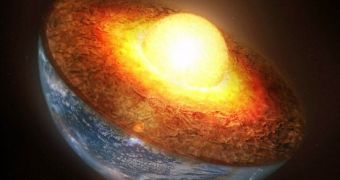Those who want to get a better idea of how our planet's iron core formed need only take one good look at their coffee machines.
Thus, Stanford University scientists now say that it is possible that Earth's core formed from blobs of iron that percolated through the lower mantle much like water filters through coffee grinds whenever somebody decides to enjoy an espresso.
The researchers detail this theory concerning the formation of the Earth's iron core in a paper published in the October 6 issue of the journal Nature Geoscience.
In their study, the scientists explain that, in its beginnings, our planet's makeup was fairly messy.
Specifically, they say that, about 4.5 billion years ago, Earth was basically one big mass of rock and metals that were crashing and clumping together in ways that would have made people who very much enjoy order go bananas.
In order for percolation to be a valid theory for the formation of our planet's iron core, scientists had to prove that environmental conditions present on Earth billions of years ago would have allowed blobs of molten iron to channel through the rock and eventually reach the planet's center.
The Stanford University researchers did so by placing a speck of iron and rock in between two diamond-tipped anvils and squeezing it while firing a laser at it.
This experiment was intended to mimic the condition present inside our planet during its early days, and proved that, billions of years ago, it was in fact possible for dribs and drabs of iron to filter inward through the rock and eventually come together in order to form Earth's core.
As explained on the official website for the Stanford University, “The scientists found that at the higher pressures and temperatures that would have been present in the early Earth's lower mantle, the structure of the silicates changed in a way that permitted connections to form between pockets of molten iron, making percolation possible.”
The researchers stress that, although their experiment proves that percolation could explain how Earth got its iron core, it does not rule out the possibility that the melting of rocks and metals in a so-called magma ocean and their getting separated into layers because of their different densities also had a say in the matter.
“Scientists had said this theory [percolation] wasn’t possible, but now we’re saying, under certain conditions that we know exist in the planet, it could happen,” geoscientist Wendy Mao said.
“We don’t know which mechanism [percolation or melting] happened first, or if the two happened together. At the very beginning, Earth would have still been very hot, and the magma ocean mechanism could have been important. But later as the planet cooled, percolation may have become the dominant mechanism,” researcher Crystal Shi added.

 14 DAY TRIAL //
14 DAY TRIAL //